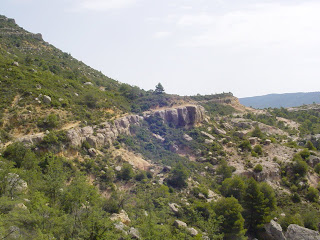I decided to head for the small village of Vilella Baixa in the Priorat region. Driving up there from Salou, on the coast, is a treat as you bypass the city of Reus and start to head into pine forested country. As you reach the town of Falset the country is already wooded and clearly "farming" land. Gratallops is another centre of agriculture but even on Sunday there is a certain village atmosphere with terrace furniture on the pavement and a handful of locals enjoying a morning drink. The road, reconditioned recently, still needs concentration as it heads inland on a windey track though pine forests alive with cicadas sounding like an orchestra of demented babies with rattles.
Arriving at Vilella I soon found the start of the trail and headed down towards the 15th century bridge which crosses the Rio Montsant (We are now in the Montsant National Park). The trail is probably extremely ancient. Before Spain had roads, all commerce was by donkey and Ox Cart along narrow trails and this one shows signs of very old paving - slabs of the local red sandstone which were probably laid 2000 years ago are still
 in evidence though many have been quarried for walls except where the locals have recognised the need for a good sound road.
in evidence though many have been quarried for walls except where the locals have recognised the need for a good sound road.The 15th century bridge at Vilella Baixa.
The track follows a Westward path, paralleling the Rio Montsant and climbing slowly through productive Vineyards. This is Priorat, the country of strong, earthy, dark wines of enormous character. Priorat wines have gained a worthy recognition worldwide and the wealth they have brought to this region is reflected in the investment in land, and buildings throughout the area.
As you move West the trail firstly passes the verdant valley of the Rio Montsant, then climbs steeply and soon you come to the Gorge of Cuevaloca, literally the "Mad Cave" though I could see no cave, just a sharp drop to a beautiful bridge built in the 1st century A.D. which confirms the pedigree of this important road as a Roman trail. Crossing over the gorge, the trail rises steeply again and enters the forest where it strives to reach the Coll de Cabacés on a two mile steep rocky path. Beyond the coll is the town, but in the 32 degree heat, after two attempts to rest and start again I finally decided to turn back.

I've become lost on trails before, but never quit, however I was getting short of water and didn't know what lay beyond the ridge so this was a sensible decision. The walk back to Vilella was pleasant and the cool beer at the end a necessary treat, after a pint of iced water!
This image is of the Roman bridge over the CovaLoca Gorge.
Whatever, walking in this area of Catlunya can be demanding, but it is always rewarding. In winter the weather is mild, so you can attempt some of the more difficult areas or just look out for migratory birds in the valleys and streams where they pass the winter. In Spring you can walk or cycle the Via Verde railway trails which have been converted for recreation, and enjoy an orange picked freshly from a tree. In summer you can try to give yourself heart failure on some of the limitless trails, as I do!









